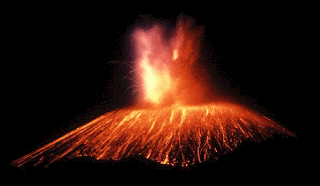Science Fact of the Week 46 - Volcanoes

Volcanoes can be mountains. But unlike most mountains in the world, formed from folding continental plates, uplift and erosion, volcanoes are created when material from inside the Earth escapes to the surface. A volcano can also be described as a place on the Earth's surface (or any other planet's or moon's surface) where molten rock, gases and pyroclastic debris erupt through the crust. Volcanoes vary quite a bit in their structure - some are cracks in the earth's crust where lava erupts, and some are domes, shields, or cone-like structures with a crater at the summit.
Magma is molten rock within the Earth's crust. When magma erupts through the earth's surface it is called lava. Lava can be thick and slow-moving or thin and fast-moving. Rock also comes from volcanoes in other forms, including ash (finely powdered rock that looks like dark smoke coming from the volcano), cinders (bits of fragmented lava), and pumice (light-weight rock that is full of air bubbles and is formed in explosive volcanic eruptions - this type of rock can float on water).
The word volcano comes from the Roman god of fire, Vulcan. Vulcan was said to have had a forge (a place to melt and shape iron) on Vulcano, an active volcano on the Lipari Islands in Italy. The largest volcano on Earth is Hawaii's Mauna Loa. Mauna Loa is about 10 km tall from the sea floor to its summit (it rises about 4 km above sea level). It also has the greatest volume of any volcano, 42,500 cubic kilometers. The largest volcano in our Solar System is perhaps Olympus Mons on the planet Mars. This enormous volcano is 27 km tall and over 520 km across. To find out more about volcanoes, click here.

Comments